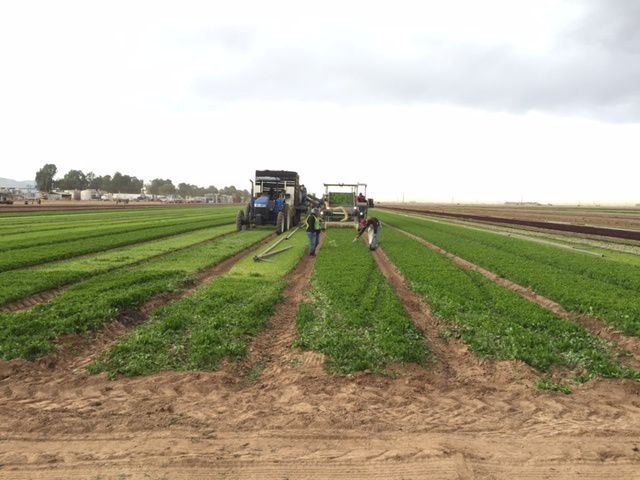Sales from Arizona Agriculture Organic Farms up 122%from 2008
Published
9/23/2015
By Dave DeWalt, USDA NASS Mountain Region Arizona Field Office State Statistician: During 2014, there were 61 certified and exempt organic farms in Arizona that sold $93.5 million worth of organic products. In comparison, 2008 had 63 of these type farms with $42.1 million in sales.

Harvesting spring mix on certified organic Duncan Family Farms, vegetables, potatoes, and melons had almost two-thirds of the total 2014 organic sales at $59.0 million for the organic industry, according to the USDA survey.
At just under $75 million, production
Nationally, there were 14,093 certified and exempt organic farms that sold $5.45 billion in organic products in 2014, up 72 percent since 2008. California was the leading state with $2.23 billion in sales. Arizona just missed the top 10 tier, coming in at number 11. Milk and eggs were the top two commodities nationally with $1.08 billion and $420 million in sales, respectively. The remaining top five commodities sold were broiler chickens, lettuce, and apples. There were 1,365 certified and exempt organic farms in
The first point of sale for 80 percent of all U.S. organic products was less than 500 miles from the farm, compared to 74 percent in 2008. In Arizona, the first point of sale for 71 percent of the organic sales
Sales to wholesale markets accounted for 78 percent of U.S. organic farm sales. Comparatively, 97 percent of Arizona’s organic farm sales were to wholesale markets. Wholesale markets, such as buyers for supermarkets, processors, distributors,
Details about the 2014 Organic Survey
The 2014 Organic Survey was conducted by the U.S. Department of Agriculture’s (USDA) National Agricultural Statistics Service (NASS) in conjunction with USDA’s Risk Management Agency (RMA). This is the third organic production and practices survey NASS has conducted on the national level; the previous data collection efforts were the 2011 Certified Organic Production Survey and the 2008 Organic Production Survey.
There are slight differences in the 3 Organic Surveys that have been conducted. The 2011 survey collected data only from certified operations, whereas the 2014 survey collected data from certified, exempt, and transitioning operations. The 2008 survey collected information from the same organic groups (certified, exempt, and transitioning) as the 2014 Organic Survey, but the 2014 survey was more comprehensive.
The 2014 Organic Survey is a census of all known organic producers in the United States that are certified, exempt from certification (those grossing less than $5,000 annually from organic sales), and those producers transitioning to organic production, as directed
Editor’s Note: Several options are provided for accessing the 2014 Organic Survey data. A PDF version of the Organic Survey results is accessible online. Data is also available via QuickStats. Visit www.agcensus.usda.gov to access the information online. Follow NASS on Twitter @usda_nass.